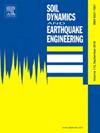液化诱发建筑沉降的分析估计
IF 4.2
2区 工程技术
Q1 ENGINEERING, GEOLOGICAL
引用次数: 0
摘要
土壤液化沉降的发生将对地震易发区的建筑物产生重大影响。以往的研究将粘阻尼力纳入控制方程来表征建筑沉降,并将视粘度作为重要参数。利用已有的方程可以预测最后阶段的沉降大小及其演变。然而,由于对表观粘度的描述不够充分,在评价沉降过程中通常将其视为常数。在采用这一机制时,建筑沉降的演变往往不能充分反映实际情况。本研究的目的是提出一个用解析微分方程表示的浅基础建筑物液化沉降的预测模型。该模型考虑了液化土的黏度随时间的变化,并引入了地震作用下液化土中土柱的概念。通过分析计算,对土体液化引起的沉降演化和最终沉降大小进行了评价,并与离心实验和数值模拟结果进行了比较。并利用该模型研究了浅基础几何特性与建筑物沉降的关系。所提出的方法作为评估建筑沉降的中间工具显示出相当大的前景,在实际场景中提供了实用的简单性。本文章由计算机程序翻译,如有差异,请以英文原文为准。
Analytical estimation of liquefaction-induced building settlement
The occurrence of settlements induced by soil liquefaction will exert a substantial influence on buildings situated in earthquake-prone regions. Previous studies integrated the viscous-damping force into the governing equation to characterize building settlements and considered the apparent viscosity as an important parameter. The existing equation can be utilized to predict the settlement magnitude in the final stage as well as its evolution. However, due to the insufficient description of apparent viscosity, it is commonly regarded as a constant during the process of evaluating settlement. When adopting this mechanism, the evolution of building settlement often proves inadequate in fully capturing actual conditions. The aim of this study is to propose a prediction model for estimating liquefaction-induced settlement of shallow-founded buildings, which is formulated by an analytically differential equation. The proposed model incorporates the time-dependent viscosity of liquefied soil and introduces the concept of a soil column submerged in liquefied soil during seismic shaking. The evolution of settlement and the final settlement magnitude induced by soil liquefaction is evaluated through the analytical estimation, and these findings are subsequently compared with the results obtained from centrifuge experiments and numerical simulations. Furthermore, the proposed model is employed to investigate the correlation between building settlement and the geometric characteristics of shallow foundations. The proposed methodology shows considerable promise as an intermediate tool for assessing building settlement, offering practical simplicity in real scenarios.
求助全文
通过发布文献求助,成功后即可免费获取论文全文。
去求助
来源期刊

Soil Dynamics and Earthquake Engineering
工程技术-地球科学综合
CiteScore
7.50
自引率
15.00%
发文量
446
审稿时长
8 months
期刊介绍:
The journal aims to encourage and enhance the role of mechanics and other disciplines as they relate to earthquake engineering by providing opportunities for the publication of the work of applied mathematicians, engineers and other applied scientists involved in solving problems closely related to the field of earthquake engineering and geotechnical earthquake engineering.
Emphasis is placed on new concepts and techniques, but case histories will also be published if they enhance the presentation and understanding of new technical concepts.
 求助内容:
求助内容: 应助结果提醒方式:
应助结果提醒方式:


